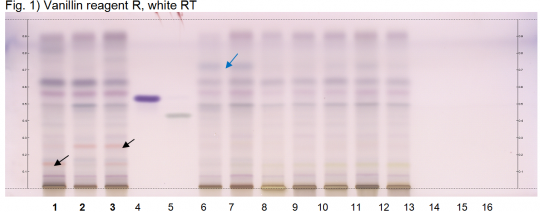Clematis armandii (root)
(Various title corrections) |
(add askbox) |
||
| Line 1: | Line 1: | ||
| − | {{DISPLAYTITLE:''Clematis armandii'' (root) }} | + | {{DISPLAYTITLE:''Clematis armandii'' (root) }} {{askbox|herb=''Clematis armandii''}} |
| − | + | ||
=Nomenclature= | =Nomenclature= | ||
| − | |||
{{nomenclature | binomial=Clematis armandii | {{nomenclature | binomial=Clematis armandii | ||
|authority=Franch. | |authority=Franch. | ||
Latest revision as of 19:32, 2 June 2014
Contents |
Nomenclature
Clematis armandii Franch. Ranunculaceae
Standardized common name (English): Armand's clematis
Pinyin name(s): xiao mu tong; chuan mu tong (stem)
Botanical Voucher Specimen
Organoleptic Characteristics
Macroscopic Characteristics
Microscopic Characteristics
High Performance Thin Layer Chromatographic Identification
|
Armand’s clematis root, xiao mu tong (root) (Clematis armandii) Lane Assignments Lanes, from left to right (Track, Volume, Sample):
Reference Sample(s) Reference: Dissolve 4.5 mg of oleanolic acid in 10 mL of methanol. Dissolve 4.5 mg of hederagenin in 10 mL of methanol. Stationary Phase Stationary phase, i.e. Silica gel 60, F254 Mobile Phase Toluene, acetone, acetic acid 32:8:2 (v/v/v) Sample Preparation Method Sample: Mix 1 g of powdered sample with 5 mL of methanol and sonicate for 10 minutes, then centrifuge or filter the solutions and use the supernatants / filtrates as test solutions. Derivatization reagent: Vanillin reagent R; Preparation: Dissolve 2 g of vanillin in 200 mL of ethanol and add 2 mL of sulfuric acid (only fresh preparation); Use: Dip (time 0, speed 5), heat at 100°C for 5 min. Detection Method Saturated chamber; developing distance 70 mm from lower edge; relative humidity 33% Other Notes Images presented in this entry are examples and are not intended to be used as basis for setting specifications for quality control purposes. System suitability test: Oleanolic acid: violet zone at Rf ~ 0.53; Hederagenin: weak grey zone at Rf ~ 0.43. Identification: Compare result with reference images. The fingerprint of the test solution is similar to that of the corresponding botanical reference sample. Additional weak zones may be present. The chromatogram of the test solution shows one blue grey zone between the positions of reference substances oleanolic acid and hederagenin. Above the position of oleanolic acid there is a weak pink zone at Rf ~ 0.57 and a blue grey zone at Rf ~ 0.62. In the lower part of the chromatogram there is a violet zone at Rf ~ 0.07. Orange zones are located at Rf ~ 0.15 and 0.25 (black arrows). Test for adulteration and other species: No bluish zone is seen at Rf ~ 0.73 (blue arrow, Clematis chinensis and C. montana). Clematis chinensis, C. montana, C. manshurica and C. hexapetala root do not show orange zones in the upper part of the chromatogram.
|
Supplementary Information
Sources
- ↑ HPTLC Association http://www.hptlc-association.org/
